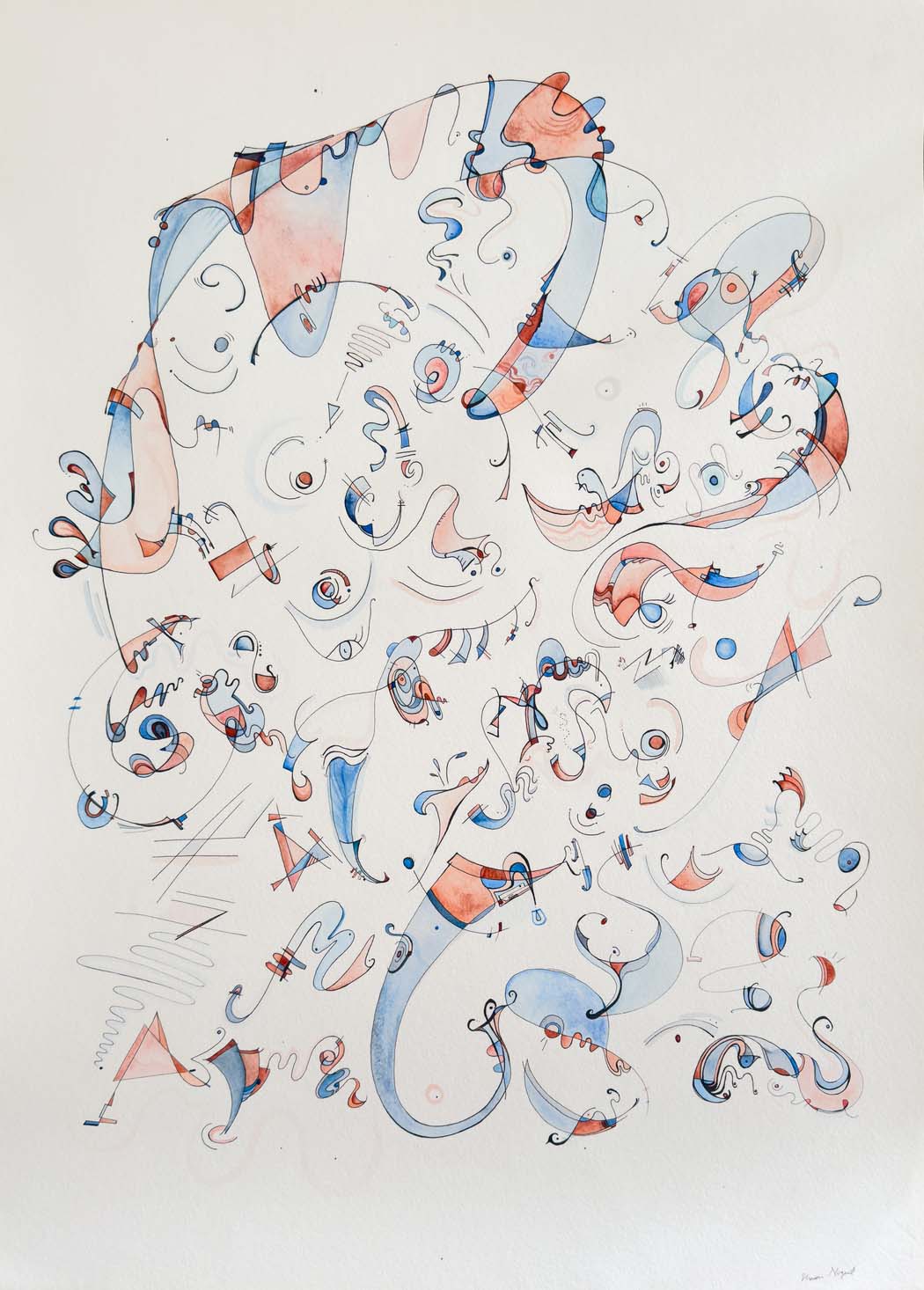Sharon Nugent
Where do you live: Barranquilla, Colombia
Your education: Bachelor of Arts in Literary Studies, Universidad de los Andes · Bachelor of Arts in Communications and Journalism, Universidad del Norte
Describe your art in three words: nostalgic · intricate · dynamic
Your discipline: painting
Website | Instagram
 Sharon Nugent | It’S All Fun And Games Until… | 2024
Sharon Nugent | It’S All Fun And Games Until… | 2024
Your work is driven by automatism. How do you shift into that intuitive state before beginning a new piece?
Before beginning any piece, I need to be relaxed enough to let my hand flow freely, even if what I want to depict is slightly chaotic or based on a difficult emotion – relaxation must precede. For that, I always play some music, get something to sip on and simply begin. All in all, not thinking too much and just getting to it is what I’ve found time and again to be key to be able to not only shift but stay in an intuitive state.
Watercolor and ink can be both fluid and unpredictable. What draws you to these mediums specifically for expressing emotion?
Well, the type of ink I use is quite easy to control, but it is impossible to correct, which adds to the pure automatic nature of my work – there are no corrections involved, and no premeditation. That is the way emotions occur: they’re immediate. Regarding watercolors, I’m precisely drawn to them because of their fluidity and unpredictability, which is ideal to capture the nuances of emotions.
 Sharon Nugent | And They Were Free | 2024
Sharon Nugent | And They Were Free | 2024
Many viewers mention finding characters and narratives hidden in your abstractions. Do you personally see figures forming during the creative process?
The truth is that I don’t always do, or when I do, it doesn’t always match what other people see, because in most cases, no shape I create is meant to be a specific depiction or anything representational. For that reason, it’s always interesting to hear the input of other people. In fact, this may be one of the things I love most about my work – the dialogue enabled by it, and how the original creation expands as it is seen through other peoples’ lenses.
 Sharon Nugent | Infinite Turquoise | 2024
Sharon Nugent | Infinite Turquoise | 2024
How does your Jewish-Colombian heritage shape your artistic identity and visual language?
I was born in Bogotá and raised in Barranquilla, an immigrant city on the Colombian coast that celebrates warmth, rhythm, and color, especially through the Carnival, but in everyday life too, really. Growing up there shaped how I approach art with emotion, and a sense of freedom and ease. My Sephardic and Ashkenazi Jewish heritage adds reflection, grounding that sense of freedom in history, memory, tradition, identity and resilience. The rich cultural environment I grew up in, together with my heritage, helped me find balance in my artistic expression, to make it my own.
You speak about balancing the weight and the lightness of life — how does color help you navigate that balance?
The multiple values of color, technically speaking, are the perfect depiction of balance. Personally, the act of creating itself is what allows me to find that balance, but only because of the almost magical, infinite possibilities of balance that color brings.
 Sharon Nugent | Thoughts By The Lake | 2025
Sharon Nugent | Thoughts By The Lake | 2025
Your compositions have a sense of motion, almost like musical notation. Do sound, rhythm, or writing influence your art?
Absolutely! Music definitely influences my compositions, but not through synesthesia – I wish I was gifted like that! It probably has to do more with technical musical training growing up and a general understanding of rhythm, and the influence of the music I play when I work. Nevertheless, I think that the rhythm in my work is derived mostly through the dynamism I see in emotions and life, maybe because not even when calm have I ever personally experienced full stillness.
 Sharon Nugent | Waiting For Night To Fall | 2024
Sharon Nugent | Waiting For Night To Fall | 2024
Are there specific emotional responses you hope viewers experience when encountering your work?
I always hope for my viewers to experience some emotion when encountering my work, and I firmly believe color can achieve that no matter what. I find that nostalgia is the one emotion that is never missing from my work thus far, but I don’t necessarily hope for the viewer to experience that. Simply put, my work cannot exist without the dialogue with the viewer and their unique lived experience.

Leave a Reply